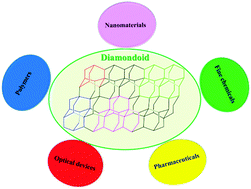Derivatization of diamondoids for functional applications
Abstract
Diamondoids, a group of hydrocarbon cage molecules that resemble diamond lattice, are attracting increasing interest in the past decade. Their diamond-like structure warrants that diamondoids inherit the superior properties of diamond at nanoscale, including exceptional hardness and stiffness, high thermal stability, high chemical resistance, unique optical properties and fluorescence, and excellent biocompatibility. To effectively take advantage of the fascinating properties of diamondoids, they must be properly functionalized so that they can be covalently incorporated into the host systems or compatibly mixed with the hosts. Herein, the origin, synthesis, derivatization, and application of diamondoids are reviewed. In particular, how the derivatized diamondoids for various functional applications, including pharmaceuticals, polymers, fine chemicals, nanomaterials, and optical devices, are discussed. It is hoped that this review article can attract more interest in diamondoids, which in turn helps motivate the development of new synthesis and application of diamondoids and their derivatives so that this group of unique molecules can bring more benefits.


 Please wait while we load your content...
Please wait while we load your content...